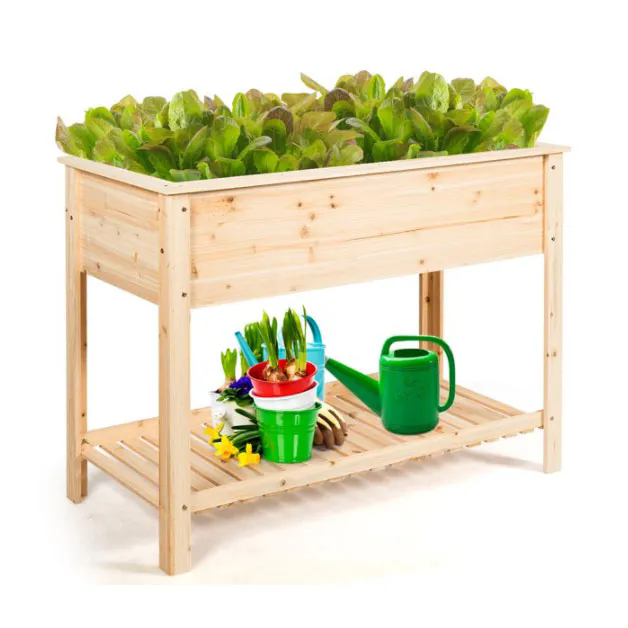The Benefits of Garden Raised Beds: A Guide to Wooden Raised Bed Gardening
2024-10-11
Gardening has long been a cherished pastime, offering not only fresh produce but also a sense of connection to nature. One of the most effective and popular methods for cultivating a garden is through the use of raised beds, particularly wooden raised beds. In this blog, we'll explore the benefits of garden raised beds, how to build them, and tips for maintaining a thriving garden.
What Are Garden Raised Beds?
Garden raised beds are elevated planting areas, typically constructed using materials like wood, stone, or brick, that allow for improved drainage, soil quality, and accessibility. They are usually rectangular or square in shape and can vary in size, making them suitable for gardens of any scale, from small urban plots to expansive backyards.
Benefits of Wooden Raised Beds
1. Improved Soil Quality
One of the primary advantages of raised beds is the ability to control the soil quality. By filling the beds with high-quality soil and compost, you create an optimal growing environment. This is especially beneficial in areas with poor or compacted soil.
2. Better Drainage
Raised beds promote excellent drainage, preventing waterlogging that can harm plant roots. This is particularly important in regions with heavy rainfall, as it helps to keep the soil consistently moist but not soggy.
3. Easier Maintenance
Gardening in raised beds reduces the strain on your back and knees since the soil is elevated. This makes planting, weeding, and harvesting much more accessible, especially for those with mobility issues or physical limitations.
4. Extended Growing Season
The soil in raised beds warms up faster in the spring, allowing for earlier planting. Additionally, the elevated structure can provide some protection from harsh weather, extending the growing season for certain plants.
5. Weed and Pest Control
Raised beds can help minimize the risk of weeds and pests. By using a barrier at the bottom of the bed, you can deter weeds from growing through. Additionally, the defined space makes it easier to manage pests and diseases.
6. Aesthetic Appeal
Wooden raised beds add charm and character to any garden. They can be constructed in various styles and stained or painted to complement your landscape, creating a visually appealing focal point.
Building Your Own Wooden Raised Bed
Constructing a wooden raised bed is a straightforward project that can be completed in a weekend. Here’s a simple guide to get you started:
Materials Needed:
- Untreated wood (cedar or redwood are ideal due to their resistance to rot)
- Wood screws or nails
- Drill or hammer
- Measuring tape
- Level
- Soil and compost
Steps to Build:
1. Choose Your Location
Find a sunny spot in your yard with good drainage. Ideally, your raised bed should receive at least 6-8 hours of sunlight daily.
2. Determine Size
Decide on the dimensions of your raised bed. A common size is 4 feet by 8 feet, but you can adjust based on your space and needs. The height should be at least 12 inches to accommodate root growth.
3. Cut the Wood
Use your measuring tape and saw to cut the wood to your desired lengths. You’ll need four pieces for the sides of the bed.
4. Assemble the Frame
Use screws or nails to assemble the wooden frame in a rectangle or square shape. Ensure the corners are square and use a level to make sure it’s even.
5. Prepare the Site
Clear the area where you’ll place the raised bed. Remove any grass or weeds, and loosen the soil underneath if possible.
6. Fill with Soil
Place the raised bed in position and fill it with a mixture of high-quality soil and compost, leaving a few inches of space at the top for planting.
7. Plant Your Garden
Now you’re ready to plant! Choose plants that thrive in your climate and enjoy the fruits of your labor.
Tips for Maintaining Your Wooden Raised Bed Garden
1. Regular Watering
Raised beds can dry out faster than in-ground gardens, so monitor moisture levels and water as needed, especially during dry spells.
2. Crop Rotation
To maintain soil health, practice crop rotation by changing the types of plants you grow in each bed from season to season.
3. Mulching
Apply a layer of organic mulch on top of the soil to retain moisture, suppress weeds, and improve soil quality over time.
4. Pest Management
Keep an eye out for pests and diseases. Use organic pest control methods and encourage beneficial insects by planting flowers that attract them.
5. Seasonal Care
At the end of each growing season, clean out dead plants and debris to prevent disease and prepare the soil for the next year.
Conclusion
Wooden raised beds are an excellent way to elevate your gardening experience, offering numerous benefits in terms of soil quality, drainage, and accessibility. With a little effort, you can create a beautiful and productive garden that provides fresh produce and enhances your outdoor space. So, gather your materials and get started on your journey to gardening success with a wooden raised bed! Happy gardening!



